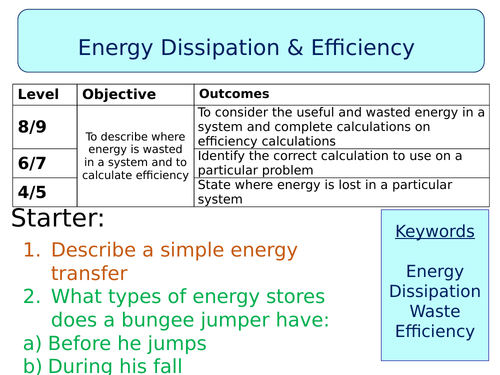
This is a lesson aimed at the new GCSE Physics specification, it meets specification points for the 'Energy' module. For more lessons within this series please visit my shop: https://www.tes.com/teaching-resources/shop/SWiftScience
This lesson begins by students considering how energy is transferred to useful or wasted energy stores and the concept of energy dissipation is introduced. The first activity involves students filling in a worksheet to identify the useful and wasted energy transfers in different systems, this is then self-assessed using the answers on the PowerPoint.
Pupils are then given the opportunity to describe the energy transfers of a pendulum, particularly thinking about why a pendulum eventually comes to a stop. Pupils can self-assess their work using the mark scheme on the PowerPoint.
Pupils are then introduced to energy 'efficiency' and how they can use the wasted and useful energy values of a system to calculate the efficiency of this device. Pupils are firstly given some easier calculations to try which can be modelled on the board, answers are provided.
Pupils can then complete the worksheet of calculations, which they can self-assess using the answers on the Power Point slide. For the last activity pupils are required to copy and complete a table, filling in missing values of either the efficiency, the wasted energy or useful energy values of different devices. Pupils can again self-assess using the answers provided.
The plenary activity is a past-paper exit card, I get pupils to hand the completed worksheet to me as they leave and I will mark it and hand it back to them for the next lesson with a grade and improvements.
Thanks for purchasing, please let me know if you have any feedback :).
Worksheets are found at the end of the PowerPoint slide and all answers are provided so pupils can peer or self-assess their work throughout the lesson.
This lesson begins by students considering how energy is transferred to useful or wasted energy stores and the concept of energy dissipation is introduced. The first activity involves students filling in a worksheet to identify the useful and wasted energy transfers in different systems, this is then self-assessed using the answers on the PowerPoint.
Pupils are then given the opportunity to describe the energy transfers of a pendulum, particularly thinking about why a pendulum eventually comes to a stop. Pupils can self-assess their work using the mark scheme on the PowerPoint.
Pupils are then introduced to energy 'efficiency' and how they can use the wasted and useful energy values of a system to calculate the efficiency of this device. Pupils are firstly given some easier calculations to try which can be modelled on the board, answers are provided.
Pupils can then complete the worksheet of calculations, which they can self-assess using the answers on the Power Point slide. For the last activity pupils are required to copy and complete a table, filling in missing values of either the efficiency, the wasted energy or useful energy values of different devices. Pupils can again self-assess using the answers provided.
The plenary activity is a past-paper exit card, I get pupils to hand the completed worksheet to me as they leave and I will mark it and hand it back to them for the next lesson with a grade and improvements.
Thanks for purchasing, please let me know if you have any feedback :).
Worksheets are found at the end of the PowerPoint slide and all answers are provided so pupils can peer or self-assess their work throughout the lesson.
Something went wrong, please try again later.
confusing as sound is not considered to be an energy store or a means of transfer
Hi Team your resources are great one issue with this bundle is that 2 lessons are written as lesson 6 and 7, so lesson 5 and 8 is not there very confusing thank you
This is excellent and really easy to use and well received by pupils
Report this resourceto let us know if it violates our terms and conditions.
Our customer service team will review your report and will be in touch.
£2.00
